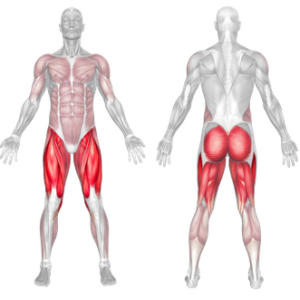Overview
The goblet squat is a simple yet effective lower body exercise targeting the quadriceps, glutes, and hamstrings. It improves squat mechanics, strengthens the core, and promotes better posture, making it ideal for both beginners and advanced lifters in strength, hypertrophy, and general fitness routines.
How to perform Dumbbell Goblet Squat

Hold a dumbbell vertically with both hands under the top portion (the weighted end), close to your chest.
Stand with feet shoulder-width apart, toes slightly turned out.
Engage your core and keep your chest lifted throughout the movement.
Push your hips back and bend your knees, lowering into a deep squat while keeping the dumbbell at chest level.
Keep your elbows inside your knees as you reach full depth, and avoid letting the knees collapse inward.
Drive through your heels to return to the standing position, fully extending your hips at the top.
Tips for Proper Form
Keep the dumbbell close to your chest to maintain balance and upright posture.
Push your knees out in line with your toes to avoid valgus collapse.
Brace your core throughout the movement for stability.
Maintain a neutral spine and avoid leaning too far forward.
Go deep enough to feel a stretch in the hips and glutes while maintaining control.
Common Mistakes
Letting the dumbbell drift forward, which shifts weight and stresses the lower back.
Knees caving inward, reducing knee stability and increasing injury risk.
Rounding the lower back, often caused by poor hip mobility or core engagement.
Rushing the movement, reducing muscle activation and control.
Shallow squatting, which limits range of motion and benefit.
Benefits of Dumbbell Goblet Squats
- Muscle and Strength Development: Goblet squats engage multiple muscle groups, including the quadriceps, glutes, hamstrings, and core. This holistic approach builds a strong foundation for improved athletic performance and injury prevention.
- Improved Squat Mechanics: The goblet squat’s core engagement and weight placement promote proper squat form, making it an excellent tool for both beginners learning the movement and experienced athletes refining their technique.
- Enhanced Balance and Proprioception: Holding the dumbbell in front of your body challenges your balance system, leading to improved proprioception (body awareness) and better coordination during functional movements.
- Minimal Equipment, Maximum Results: This exercise requires only a single dumbbell, making it a versatile choice for home workouts or facilities with limited equipment.
- Beginner-Friendly Movement Pattern: The goblet squat’s controlled movement and focus on proper form make it an ideal exercise for those new to strength training or looking to refine their squat technique.
How to Incorporate Into Your Routine
The Dumbbell Goblet Squat suits a wide range of training goals from beginner-friendly strength work to advanced conditioning circuits. Here are tailored options:
- For Beginners: Perform 2 to 3 sets of 8 to 10 reps using a light dumbbell to master depth, posture, and control.
- For Hypertrophy: Use 3 to 4 sets of 10 to 12 reps focusing on time under tension and quad-glute engagement.
- For Strength: Perform 4 sets of 6 to 8 reps with a heavier dumbbell, prioritizing bracing and full range of motion.
- For Functional Training: Use 2 to 3 sets of 8 reps paired with movements like lunges or carries to enhance movement quality and balance.
- For Circuit Training: Add 10 to 12 reps as a lower body movement in a full-body circuit with minimal rest.
- For General Fitness: Include 2 to 3 sets of 10 reps in your weekly workouts to maintain strength and movement efficiency.
- As a Mobility Drill or Warm-Up: Do 1 to 2 sets of 6 slow bodyweight reps to prepare hips and ankles for squatting.
Muscles Worked

Frequently Asked Questions
Is the goblet squat good for beginners?
Yes, it’s one of the best beginner-friendly squat variations because it teaches proper mechanics and builds strength safely.
Can I do goblet squats every day?
You can do them frequently at light to moderate intensity to improve mobility, but for muscle growth, allow rest between heavy sessions.
What weight should I use?
Start with a manageable weight that allows you to squat deeply with control. Gradually increase as strength and form improve.
Is it better than a barbell squat?
Not better, just different. Goblet squats are easier to learn, safer for solo workouts, and great for building foundational strength.
